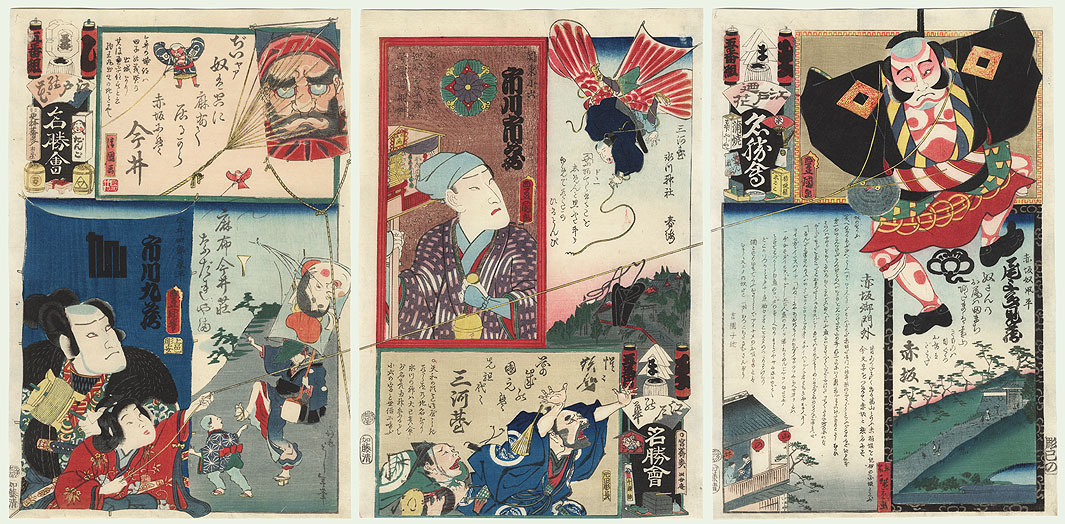| |
TOYOKUNI-III (KUNISADA)(1786 - 1864)'Kite Flying Triptych'(descriptive title) |
 |
|
'Kite Flying Triptych' Series: "Flowers of Edo and
Views of Famous Places" |
| Comment - This
triptych is from the series "Flowers of Edo" and
features kite-flying themes. A kite string is running
continuously across all three panels to connect to the
yakko-dako or man kite ("yakko dako", "奴凧") at right
panel, upper right. At the left panel, a young boy holds
the end of the kite string, while the image to his right
shows a street musician knocked on the head by a falling
Edo kite ("Edo-tako", "江戸凧") with an image of Okame, the goddess of
mirth. The person behind the boy, holding the boy's kite
line spool, seems to be a picture on a large blue Edo kite
in the background. The A large Edo kite with a Daruma picture, flies in
the left panel upper cassette, next to the fire brigade
coat-of-arms (Shi Brigade, Fifth Group, Imai; see left
panel, upper left cassette). Next to the Daruma kite, a
smaller yakko-dako and a bird-of-prey kite ("tonbi dako",
"鳶凧") are to be seen. In the center panel, a man goes
flying up into the sky along with a bird kite, loosing his
head wear, the broken string fluttering in the air, while
at bottom two men rush forward, alarmed by his flight. At
right, the yakko-dako kite floats above a landscape, the
yakko detailed with burnishing in the black kimono and
socks. Note that the yakko-dako is tied with a black rope
(stick) on his back to the upper selvage, making it a real
stage play scene. The panels are interconnected, not only by the theme (Fire Brigades) and the Yakko kite string, running over all three panels, but also by each of their own stories. The large Yakko kite on the left panel also belongs to an episode of Bakin's stories (Bakin chojutsu, 馬琴著述) named "A Soldier's Dream Story" ("Musō hyōe kochō monogatari", "夢想兵衛 胡蝶物語"). It is connected to the the bird-of-prey kite ("tonbi dako", "鳶凧") at the adjoining central panel. Two woodblocks depicting this story are to be seen by another print of Kunisada himself ("Dream of a Palace Guardsman") and Chikanobu ("Man Riding a Kite"). Nevertheless, all individual panels also contain stories of their own. |
Left panel - Forms the left sheet of a triptych of kite-flying themes, with a continuous kite string. Title - Center panel - Forms the center sheet of a triptych of kite-flying themes, with a continuous kite string. Title - Right panel - Forms the right sheet of a triptych of kite-flying themes, with a continuous kite string. Title - Series - Flowers of Edo and Views of Famous Places - Design from a series by TOYOKUNI-III pairing kabuki actors with famous areas of Edo and firemen's standards, done in collaboration with several different artists. TOYOKUNI-III created the large actor portraits, while other artists such as HIROSHIGE-II (SHIGENOBU), SADAHIDE, KUNIHISA-II, YOSHITORA, KUNISADA-II, YOSHITOSHI, and KYôSAI contributed the landscape designs and other scenes across the top. The term "Flowers of Edo" in the title here refers to fires, and each title cartouche features the standard or "matoi" and lantern of a different Edo fire brigade. The expressive portraits are beautifully detailed with fine line work and an intricate wood grain background. A beautifully printed series, with many images featuring fine shading, embossing, or touches of burnishing. The term “flowers of Edo” (Edo no hana) can refer, among other things, to fires. The title panel for each print in this series shows the lanterns and identifying standard (matoi) for one of the brigades of firefighters (hikeshi) assigned to various districts. On the west side of the Sumida River were 48 brigades named for the symbols of the kana syllabary and grouped into 8 numbered groups (1 to 10, minus the bad-luck numbers 4 and 7). On the east side of the river, brigades were numbered and assigned to directional groups. Outlying districts were covered by special brigades, here designated “extra” (bangai). Each title gives the name or number of a brigade, its group, and its district, followed by the kabuki scene chosen to match it. Artist - see Biography (TOYOKUNI-III) Signature - see individual panels Publisher - Katō-ya Iwazō (加藤屋岩蔵) Kibi-dō Publisher's (吉美堂) Image Size - (Tryptich) 33.0 x 69.6 cm (13 1/4" x 27 1/2") + outside margins as shown Condition - Triptych, three separate panels; woodblock print (nishiki-e); ink and color on paper; all vertical ôban (tate-e); |
Copyright 2008 ff: Hans P. Boehme